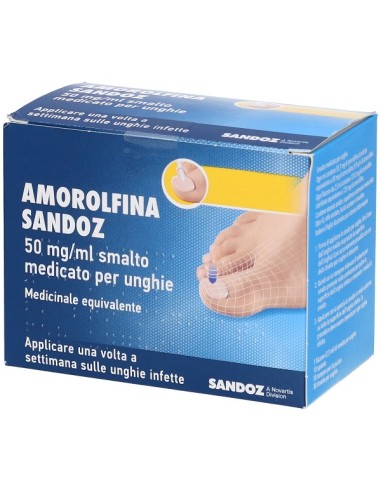Your cart
There are no more items in your cart
Antifunct Amorolfina san enamel 2,5ml Sandoz
OTHER MEDICINAL PRODUCTS SANDOZ 50 MG/ML MEDICAL SMALL FOR UNGHIES
active ingredients
Each ml contains 55.7 mg of amorolfina hydrochloride equivalent to 50 mg of amorolfina (5% p/v of amorolfina). Each 2.5 ml bottle contains 139.3 mg of amorolphine hydrochloride equivalent to 125 mg of amorolphine. Each 3 ml bottle contains 167.1 mg of amorolphine hydrochloride equivalent to 150 mg of amorolphine. Each 5 ml bottle contains 278,5 mg of amorolphine hydrochloride equivalent to 250 mg of amorolphine. For the full list of excipients, see paragraph 6.1.Excellent
Anidro ethanol, Methacrylate ammonium copolymer (type A), Acetate ethyl, Butile Acetate, Triacetin.Therapeutic indications
Treatment of onicomycosis caused by dermatophytes, yeasts or molds, without involvement of the ointment matrix in adults.Contraindications
Hypersensitivity to the active ingredient or any of the excipients listed in paragraph 6.1Population
Population: Nail polish should be applied on the nails affected by the fingers of the hand or foot once a week. Method of administration: For topical use. To be applied on the interested nails. 1. Before each application, smooth the area of the sick nail (especially the nail surface) as accurately as possible with a nail file supplied in the package. The surface of the nail must be cleaned and degreased using one of the soaked tampons of enamel solvent (included in the packaging). Before repeating the next application of Amorolfina Sandoz nail polish medicated, this process of smoothing and cleaning must be repeated, so as to remove the existing residual nail polish. Attention! Nail limettes used for treatment should not be used for healthy nails .2. With a spatula supplied, apply the enamel on the entire surface of the sick nail and let it dry. For each nail to be treated, immerse the spatula in the enamel. Attention! The spatula should not be rubbed on the edge of the bottle . After use, clean the spatula with the soaked tampon of enamel solvent. After the application of Amorolfina Sandoz nail polish, a range of at least 10 minutes must be respected before applying a cosmetic nail polish. It is important to wash your hands after applying Amorolfina Sandoz medicated nail polish. If Amorolfina Sandoz nail polish is applied on the fingers of the hand, patients must wait for them to dry before washing their hands. Duration of treatment: The treatment must be continued without interruption until the nail has regenerated and the affected area is completely healed. In general, it takes 6 months of hand nail therapy and 9 to 12 months for the nails of the feet (the duration of the treatment depends essentially on the intensity, location and extension of the infection). After a 3 month treatment without results, consult your doctor. Pediatric population: Due to the lack of clinical experience, children and adolescents should not be treated with Amorolfina Sandoz nail polish medicated. Seniors: There are no specific dosage recommendations for use in elderly patients.Conservation
Keep the bottle well closed Keep the nail polish medicated away from fire or flame (the alcohol base is flammable)Warnings
During the application of Amorolfina Sandoz, artificial nails should not be used. In case of use of organic solvents, it is good to wear waterproof gloves not to remove the layer of Amorolfina Sandoz on the nails, otherwise it will be removed. After the application of Amorolfina Sandoz nail polish, a range of at least 10 minutes must be respected before applying a cosmetic nail polish (if desired). However, with repeated use of Amorolfina Sandoz nail polish, any applied nail polish should be removed before applying a new layer of Amorolfina Sandoz nail polish. Due to the lack of clinical experience, children and adolescents should not be treated with Amorolfina Sandoz nail polish medicated. Avoid any contact of the enamel with eyes, ears and mucosa. The treatment must be established by the doctor in the case of patients suffering from peripheral vascular diseases, diabetes, immune system diseases, as well as in patients with ointment dystrophy or severely damaged nails (with injuries greater than two-thirds of the nail). In these cases, systemic therapy must be planned. Patients with previous history of injury, skin conditions such as psoriasis or other chronic condition of the skin, edema, respiratory disorders (Jellow syndrome), sore nails, distorted/deformed nails or other symptoms should contact the doctor before starting treatment.Interactions
Interaction studies have not been carried out.Effects
Tabulate list of adverse reactions:| Systemic-organic class | Incidence | Adverse reactions |
| Immune system disorders | Not common (≥1/1.000 a | Hypersensitivity (allergic reaction) |
| Pathologies of skin and subcutaneous tissue | Rare (≥1/10.000 a | Nail disorders, onicoclasia (broken nails), alteration of the color of the nail, onicoressi ( fragile nails) and weak nails |
| Very rare ( | Sensation of skin burning | |
| Notable (can not be defined on the basis of available data) | Erythema, itching, contact dermatitis, hives, bladders |
Overdosing
No overdose symptoms are expected as a result of the topical application of amorolfina 5% nail polish. In case of accidental oral ingestion, if necessary, all appropriate measures should be taken to treat symptoms.Pregnancy
: Reproductive toxicology studies showed no evidence of teratogenicity in laboratory animals, but embryotoxicity was observed at high oral doses of amorolfina. The clinical experience related to the use of amorolfina during pregnancy and nursing is limited. Systemic absorption of amorolfina during and after topical administration is very low, so the fetal risk in humans would seem to be negligible. However, since there is no significant experience, amorolphine should be avoided during pregnancy.Food
: It is not known if amorolfina is excreted in breast milk. Since there is no significant experience, amorolphine should be avoided during breastfeeding.Fertility
: There are no available data.Source: Farmadati
- Deductible product
- Yes
047512013
33 Items
New
No reviews

